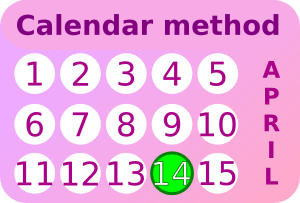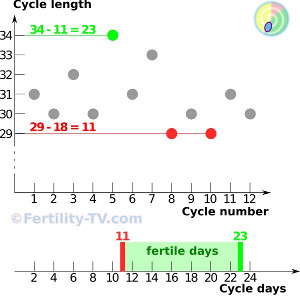 Is it easier to get pregnant with the Calendar Method and calculate the fertile days? Everything about the Calender Method and how it works.
Is it easier to get pregnant with the Calendar Method and calculate the fertile days? Everything about the Calender Method and how it works.
Again and again, we have women in our fertility consultation who use the Calendar Method to calculate the fertile days in order to get pregnant faster and easier. But is the Calendar Method really worthwhile? How does it work? And can you really calculate the fertile days, or is that not possible? In this article, I’ll show you exactly how the Calendar Method works. To find out how good the Calendar Method really is, I will compare it with the best method for the desire to have children right now. For the comparison to be really realistic, I will use my girlfriend’s real cycles. After this article, you will know exactly whether the Calendar Method is really worthwhile for you.
Calculation of fertile days according to the Calendar Method
To apply the Calendar Method, you have to keep a menstrual calendar, because you have to have your longest and shortest cycle ready. According to KNAUS and OGINO’s Calendar Method, ovulation is always 14 days before the next menstruation. In addition, the method of KNAUS and OGINO assumes that the sperm in the woman’s body can survive for about three days. These two assumptions result in the following calculation requirements for the fertile days:

Shortest cycle minus 18 days = First fertile day
Longest cycle minus 11 days = Last fertile day
Calendar Method Example:
With my girlfriend, the length of a cycle varies between 29 and 34 days. Now 34-11 = 23 and 29-18 = 11 are expected. This makes my girlfriend fruitful according to the Calendar Method from the 11th to the 23rd of the cycle.
Is the Calendar Method worth it if you wish to have a child?
To clarify whether the Calendar Method is really worthwhile, I conducted a small Calendar Method experiment. First, I took my girlfriend’s first 12 cycles and determined the fertile days once using the Calendar Method and once with the Symptothermal Method (NFP). The Symptothermal Method is based on body observation of cervical mucus and basal body temperature. In contrast to the Calendar Method, the fertile days are determined according to fixed rules by an evaluation of the measured temperature curve in combination with the documented cervical mucus progression. The Symptothermal Method (NFP) is currently the best method for the desire to have children, it can limit ovulation to a few days and reliably determine the highly fertile days. I summarized the result in the table below.
Fertile days according to KNAUS’s and OGINO‘s Calendar Method: 11th to 23rd Cycle Day (CD)
| Cycle No: |
Length | Fertile Days | Deviation Symptothermal Method vs Calendar Method |
|---|---|---|---|
| C1 | 31 days | 1. to 27. cycle day | 10 days and 4 days |
| C2 | 30 days | 6. to 23. cycle day | 5 days and 0 days |
| C3 | 32 days | 6. to 22. cycle day | 5 days and 1 day |
| C4 | 30 days | 6. to 22. cycle day | 5 days and 1 day |
| C5 | 34 days | 6. to 26. cycle day | 5 days and 3 days |
| C6 | 31 days | 11. to 23. cycle day | 0 days and 0 days |
| C7 | 33 days | 11. to 25. cycle day | 0 days and 2 days |
| C8 | 29 days | 11. to 21. cycle day | 0 days and 2 days |
| C9 | 30 days | 10. to 22. cycle day | 1 day and 1 day |
| C10 | 29 days | 10. to 22. cycle day | 1 day and 1 day |
| C11 | 31 days | 10. to 24. cycle day | 1 day and 1 day |
| C12 | 30 days | 10. to 26. cycle day | 1 day and 3 days |
Evaluation of the Calendar Method experiment
The Calendar Method is particularly inaccurate in determining the beginning of the fertile days, here I was able to calculate an average deviation of 2.8 days. For the end of the fertile period, I was able to calculate about 1.6 days of deviation from the cycles when comparing the Symptothermal Method to the Calendar Method. However, the experiment also shows that the number of fertile days at the beginning of the cycle can vary up to 10 days and at the end of the cycle can vary up to 4 days. For this reason, the woman must decide for herself whether she wants to use such a flat rate uncertain determination of the fertile days for the desire to have children.
The Calendar Method is from a time when you still knew very little about the cycle. It is so inaccurate because it is based on false assumptions. First, the Calendar Method assumes that the ovulation is always exactly 14 days before the next menstruation. Studies have shown, however, that the timing of ovulation can vary between 12 and 16 days before menstruation. Secondly, the Calendar Method actually only works only if the woman’s cycle length hardly fluctuates. Because the greater the deviation between the longest and shortest cycle, the more fertile days you have to assume. Studies show that cycle length in a healthy woman can fluctuate between 23 and 35 days. By Calendar Method, this would mean that the woman is fertile between the 5th and 24th Cycle Day. Well and for the statement that I’m almost always fertile, I don’t need a method, do I?
My conclusion on the Calendar Method
Overall, I cannot recommend the Calendar Method if I desire to have a child, there are better methods. My girlfriend got pregnant with the Symptothermal Method in the first trial cycle. Thanks to the Symptothermal Method, she knew exactly when she is highly fertile and was also able to determine when she had her ovulation. The absolute highlight for me personally was that it is possible to determine without pregnancy test whether you have become pregnant. In the meantime, we have two kids thanks to the Symptothermal Method and it worked out twice in the first cycle. This was no coincidence, as Studies show that women with Symptothermal Method have an increased pregnancy rate. In a 2003 study, a pregnancy rate of 81% was achieved after 6 months, in comparison to the pregnancy rate without the Symptothermal Method which is only about 60% after the first 6 months. If you want to start with the Symptothermal Method now, I can recommend my Get Pregnant Starter Set. There I explain you everything you need to start as soon as possible.
Extending Fertile Greetings
Marcus Krahlisch



